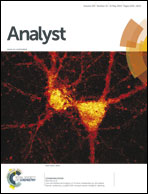Ionization characteristics of amino acids in direct analysis in real time mass spectrometry†
Abstract
The positive and negative ionization characteristics of 20 different α-amino acids were investigated using Direct Analysis in Real Time (DART) mass spectrometry. Almost all of the amino acids M were ionized to generate the (de)protonated analytes [M ± H]±via proton transfer reactions with the typical background ions H3O+(H2O)n and O2˙− and resonant electron capture by M. The application of DART to amino acids also resulted in molecular ion formation, fragmentation, oxidations involving oxygen attachment and hydrogen loss, and formation of adducts [M + R]− with negative background ions R− (O2˙−, HCO2−, NO2− and COO−(COOH)), depending on the physicochemical and/or structural properties of individual amino acids. The relationship between each amino acid and the ionization reactions observed suggested that fragmentation can be attributed to pyrolysis during analyte desorption as well as excess energy obtained via (de)protonation. Oxidation and [M + R]− adduct formation, in contrast, most likely originate from reactions with active oxygen such as hydroxyl radicals HO˙, indicating that the typical background neutral species involved in analyte ionization in DART mass spectrometry contain HO˙.


 Please wait while we load your content...
Please wait while we load your content...